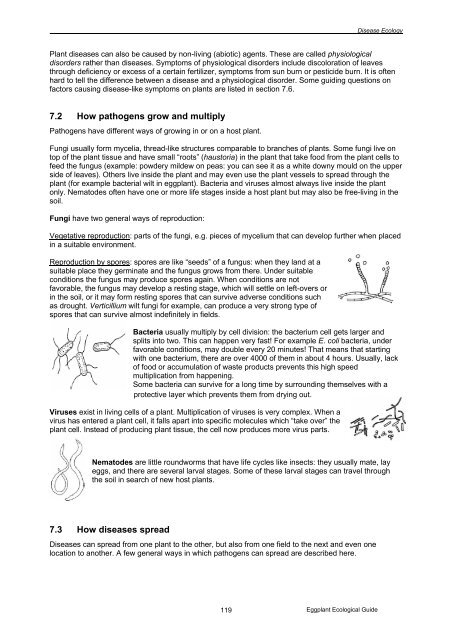Eggplant Integrated Pest Management AN ECOLOGICAL GUIDE
Eggplant Integrated Pest Management AN ECOLOGICAL GUIDE
Eggplant Integrated Pest Management AN ECOLOGICAL GUIDE
You also want an ePaper? Increase the reach of your titles
YUMPU automatically turns print PDFs into web optimized ePapers that Google loves.
___________________________________________________________________________________________Disease EcologyPlant diseases can also be caused by non-living (abiotic) agents. These are called physiologicaldisorders rather than diseases. Symptoms of physiological disorders include discoloration of leavesthrough deficiency or excess of a certain fertilizer, symptoms from sun burn or pesticide burn. It is oftenhard to tell the difference between a disease and a physiological disorder. Some guiding questions onfactors causing disease-like symptoms on plants are listed in section 7.6.7.2 How pathogens grow and multiplyPathogens have different ways of growing in or on a host plant.Fungi usually form mycelia, thread-like structures comparable to branches of plants. Some fungi live ontop of the plant tissue and have small “roots” (haustoria) in the plant that take food from the plant cells tofeed the fungus (example: powdery mildew on peas: you can see it as a white downy mould on the upperside of leaves). Others live inside the plant and may even use the plant vessels to spread through theplant (for example bacterial wilt in eggplant). Bacteria and viruses almost always live inside the plantonly. Nematodes often have one or more life stages inside a host plant but may also be free-living in thesoil.Fungi have two general ways of reproduction:Vegetative reproduction: parts of the fungi, e.g. pieces of mycelium that can develop further when placedin a suitable environment.Reproduction by spores: spores are like “seeds” of a fungus: when they land at asuitable place they germinate and the fungus grows from there. Under suitableconditions the fungus may produce spores again. When conditions are notfavorable, the fungus may develop a resting stage, which will settle on left-overs orin the soil, or it may form resting spores that can survive adverse conditions suchas drought. Verticillium wilt fungi for example, can produce a very strong type ofspores that can survive almost indefinitely in fields.Bacteria usually multiply by cell division: the bacterium cell gets larger andsplits into two. This can happen very fast! For example E. coli bacteria, underfavorable conditions, may double every 20 minutes! That means that startingwith one bacterium, there are over 4000 of them in about 4 hours. Usually, lackof food or accumulation of waste products prevents this high speedmultiplication from happening.Some bacteria can survive for a long time by surrounding themselves with aprotective layer which prevents them from drying out.Viruses exist in living cells of a plant. Multiplication of viruses is very complex. When avirus has entered a plant cell, it falls apart into specific molecules which “take over” theplant cell. Instead of producing plant tissue, the cell now produces more virus parts.Nematodes are little roundworms that have life cycles like insects: they usually mate, layeggs, and there are several larval stages. Some of these larval stages can travel throughthe soil in search of new host plants.7.3 How diseases spreadDiseases can spread from one plant to the other, but also from one field to the next and even onelocation to another. A few general ways in which pathogens can spread are described here.119<strong>Eggplant</strong> Ecological Guide




![Section 4 [ PDF file, 252 KB] - The Field Alliance](https://img.yumpu.com/51387260/1/158x260/section-4-pdf-file-252-kb-the-field-alliance.jpg?quality=85)











